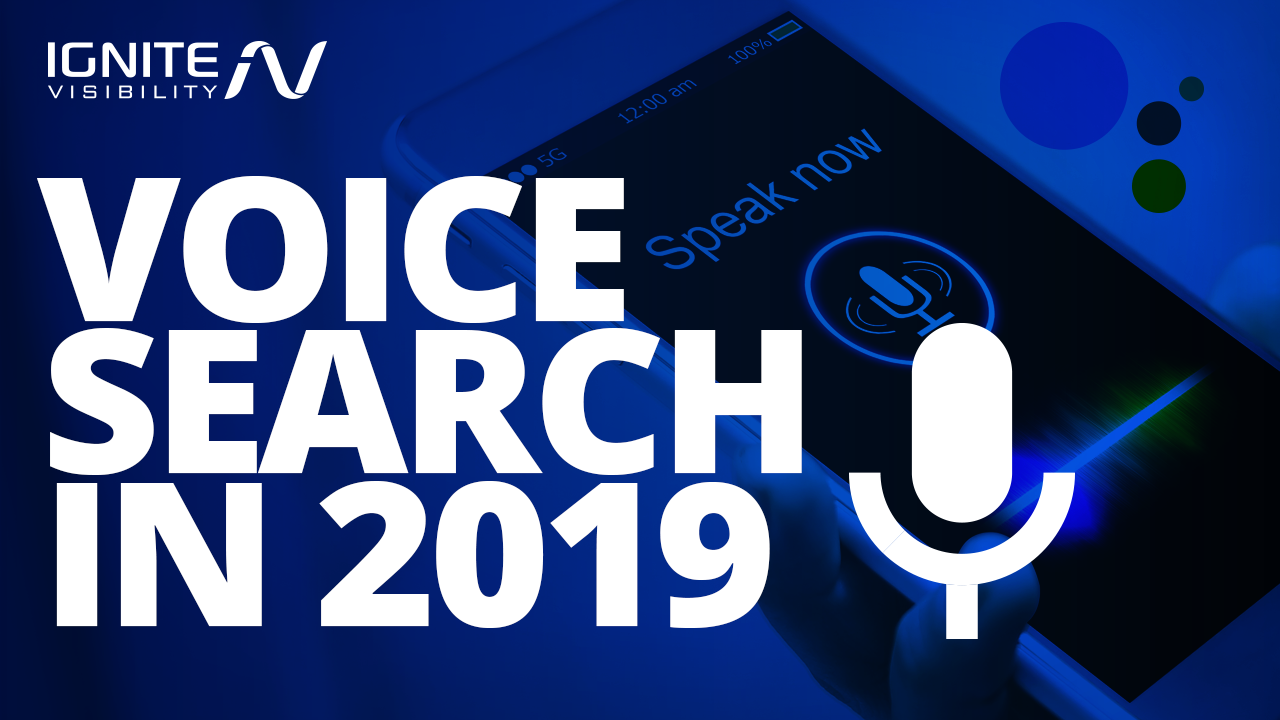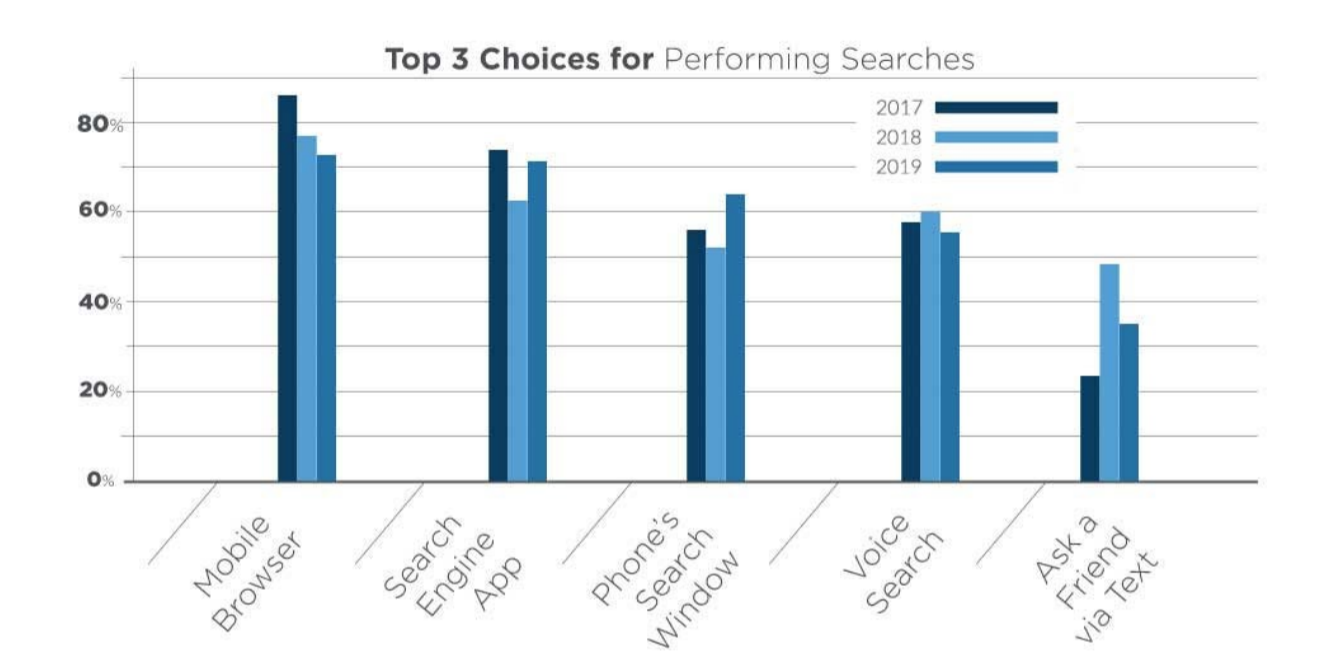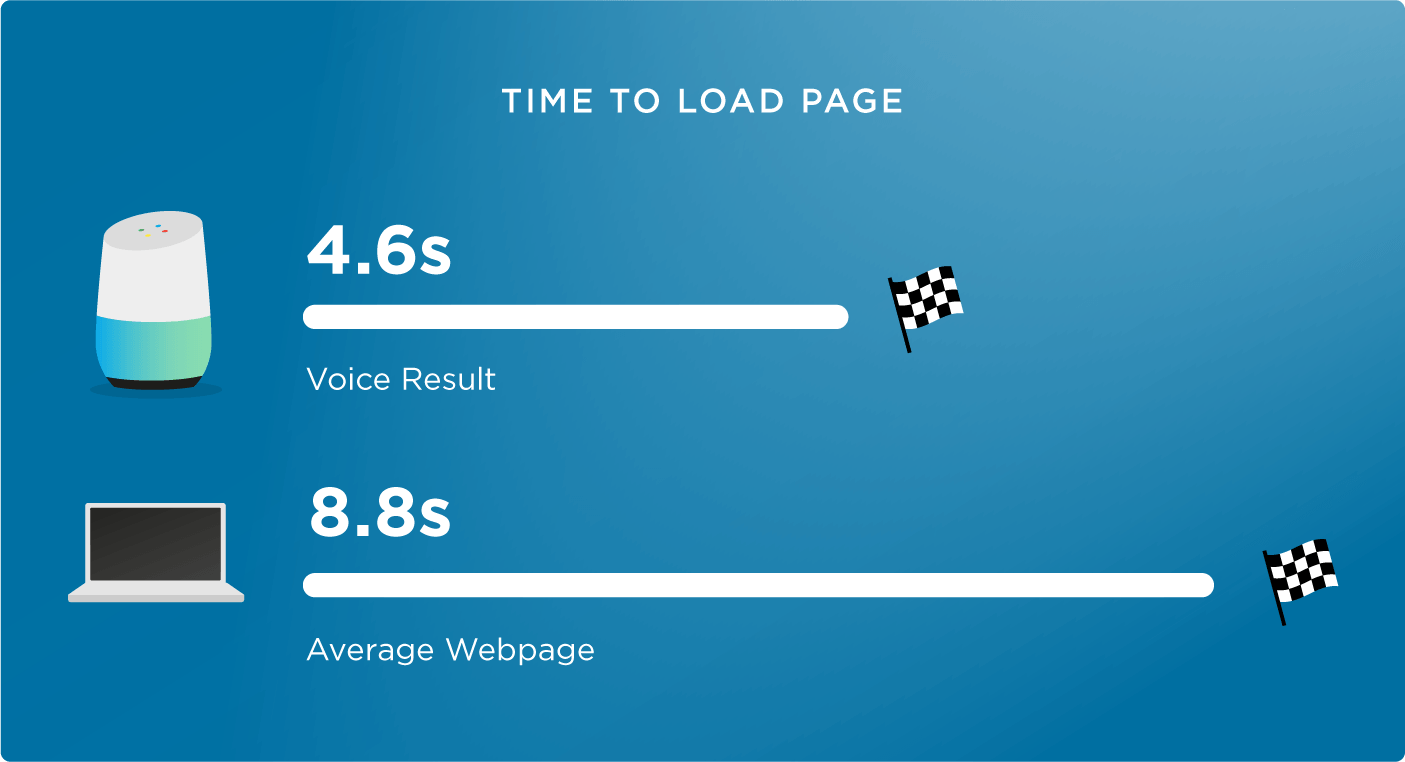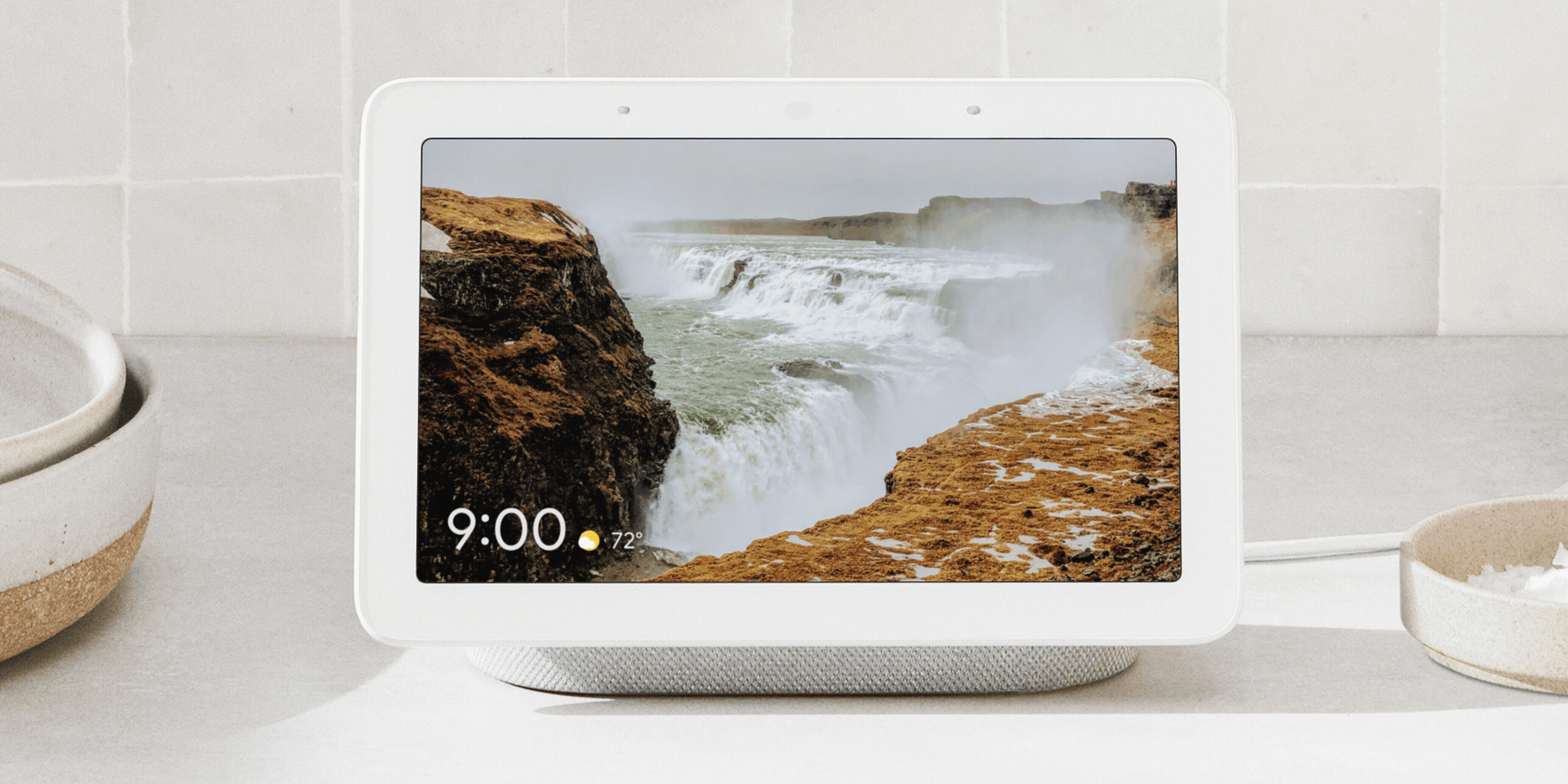Though it’s not exactly new, voice search is still very much a novelty when it comes to marketing.
But as it gains a firmer footing in consumers lives and makes it way into marketing strategies, it’s important to keep on top of all the new developments and how they may affect your brand’s approach to voice.
In this article, I’ll cover all the major developments in voice search you need to know in 2019.

What We’ll Cover:
- Voice search shifts towards intent
- Voice search is (still) all about local
- Featured snippets and voice search
- Google Assistant speeds are on the rise
- No more wake words?
- Amazon Alexa and e-commerce brands
- Optimizing for Bing and Amazon Alexa
- Google Assitant updates:
- Get ready for shifting search behaviors
- Overview of voice search optimization in 2019
Voice search was introduced by Google in 2011, though only over the past couple of years has it been a reliable resource for consumers.
In 2019, we have access to smart assistants, voice-activated mobile search, and AI-driven answers that match our intent. As voice technology improves, it’s increasingly becoming a vital piece of the SEO puzzle.
According to a recent study from Stone Temple, voice search is less popular than it was a year ago, but I’m guessing these numbers mean that voice search is no longer a novelty. In 2019, digital assistants, Google, Alexa, Siri, and Cortana (did I forget anyone?) are getting a promotion.
The study found that voice was ranked fourth among searchers using their phone to find information. In case you were wondering, mobile browsers are peoples’ top choice for looking up information on the go.

Voice search 2019: studies show that voice search is trending down in popularity
However, that doesn’t mean that it’s slowing down. In fact, 2019 has been a landmark year for voice search. More and more, people are beginning to realize that their digital assistant helps them multitask and get things done fast–no hands required.
In this article, I’ll cover some of 2019’s biggest voice developments–and how they’re shaking up the SERPs as we know them.
Voice Search 2019: A Shift Toward Intent
You probably know this scenario all too well.
If you’ve ever performed a voice search on your phone, you probably were looking for a particular piece of information. That might be a “near me” coffee shop with WiFi. Or, maybe it’s a grocery store that’s open past 11 pm.
Whatever it is, you want to find local business information quickly, without having to scroll through multiple pages to find it.
So, as you think about voice search 2019 from the customer point of view, the intent is the key thing that keeps coming up time and time again. This might seem overly simplistic, but capitalizing on intent means making sure things like your business hours and street address are marked up and easy to find.
The easier you make it for Google’s spiders to crawl your site and pull up critical information, the more likely it is to appear in “near me” searches.
As such, make sure this information is available as plain HTML, rather than hiding it in an image or an obscure web page.
The second part of thinking about intent is about the products and services you sell. This means answering any questions prospects and visitors might have about what you do—even if it’s evident from an insider’s perspective.
Voice Search 2019: It’s All About Local (and Hyperlocal)
Even in 2019, only about 4% of all shopping takes place online, and roughly 40% of all Google searches suggest local intent. This means if you’ve got a brick and mortar business, be it a gym, a spa, or a restaurant, you can’t sleep on optimizing your Google My Business listing.
The reason this matters so much for voice search is, Google will start to send more “near me” searchers your way, increasing your chances of ranking for voice.
Beyond claiming your GMB listing, make a point of collecting reviews (and responding to them). Make sure to add any relevant mark-up like booking schema or other profile enhancements to make key details easy to find for searchers. Optimize your meta descriptions, add photos, and use location-specific keywords.

Voice search in 2019 is heavily driven by local search. Make sure you’ve claimed your Google My Business listing.
There’s a lot to do here, so if you’d like to learn more, I recommend checking out this guide to optimizing GMB for local.
As far as getting “hyperlocal” for voice, the main opportunity here is to capitalize on near-me searches with high commercial intent within a super small radius. So, you might run ad campaigns to people a few blocks away promoting a special offer to get them in the door.
Google has been revamping local search over the past few years, and those businesses that pay special attention to their GMB profile have some major opportunities to profit in person.
Not Local? Snippets Are Your Key to Better Voice Results
Though online-only businesses miss out on the opportunity to use maps, booking schema, and SEO-friendly GMB profiles, they can still benefit from rich results.
I recommend looking over the Google guides if you’re new to rich results, but the thing to know here is that voice assistants often read from the snippets. Meaning, brands that can secure position zero stand to really boost “visibility” in the SERPs regardless of format.
While (for whatever reason) Google has yet to bring voice into the search console reporting dashboard, you can review rich results performance in GSC.
For marketers, looking at the performance of your rich results could reveal a bit more about voice ranking signals.
Google Assistant Speeds Are on the Rise
If you look at any of the footage from Google’s 2019 Marketing Live event, you’ll notice that CEO Sundar Pichai and other executives are all about machine learning these days.
One key area where we see a lot of action on the machine learning front is Google Assistant’s speech recognition.
The company announced that improved speech recognition and neural networks were making their way to smartphones with the Assistant installed, stating that processing speeds could be up to 10x faster.
And, while that might not seem like it impacts advertisers a whole lot, that progress could be a significant game-changer. On the customer side, near-instant results could increase adoption, thus making voice an even bigger deal for organic.
Voice Search 2019: No More Wake Words?
Google and Amazon both recently announced that their branded assistants will no longer require the use of wake words. Well, at least repeated use.
Thus far, both assistants have relied on the wake word– “Alexa…” or “Okay, Google…” to let the device know that a new conversation was starting.
Eliminating the wake word seems like a small thing, but it might have a significant impact, at least as far as usability is concerned. After all, you don’t say someone’s name each time you ask them a question.
E-commerce Brands Need to Embrace Alexa
Or, let me rephrase that–e-commerce brands that sell on Amazon need to focus on optimizing for Alexa. Google might be hogging the conversation surrounding Voice search, but marketers need to keep an eye on Amazon’s Alexa, too.
Naturally, one of Alexa’s most significant benefits comes from the fact that you can use it to place orders on Amazon.
If you say something like, “Alexa, order more paper towels,” she’ll (it?) respond by giving you some product info, then asking if you’d like to place the order.
Alexa will consult the user’s shopping history to make recommendations based on past purchases, though if there are no existing matches, you’ll get suggestions based on popular products.
If, for example, she recommends one-ply rolls, then you might say “no,” and she’ll suggest a few more options.
Of course, Alexa is a no-brainer for sellers that have products on Amazon, as according to this Inc. article, 37% of millennials say that they “always or usually” shop by voice.
Optimize for Alexa Search by Optimizing for Bing
While Amazon’s Alexa is best known for playing music and helping you make even more Amazon purchases, it’s also a digital assistant designed to answer search queries, just like Google.
If you’ve done some work on the Bing front, you’re already halfway there. Alexa actually gets its information from Bing’s search engine. This means you’ll need to use Bing Webmaster Tools to optimize your content for Amazon Voice.
Google Assistant answers queries by tapping into its proprietary search index and using algorithmic data to deliver the appropriate response.
Alexa, by contrast, directs queries to the cloud. This makes sense, given that most information on Amazon is related to its products. From there, the question is sent to an app (or downloaded skill) or the Bing engine.
Voice Search 2019: Speed Matters, Even When There’s No Screen
According to Backlinko, page speed might also play a role in whether your site makes it into the voice results.

Voice search 2019: the faster the page speed, the more likely it is to appear in voice results. Image courtesy of Backlinko.
As such, you’ll need to make sure your site loads quickly, is mobile-friendly, and that all media is compressed. Sure, there’s more to consider, here, but speed is an excellent place to start. Think about it this way, if Google delays in giving you an answer, you might assume the WiFi slowed down or it “didn’t get that.”
Voice Search 2019: Google Assistant Updates
When we talk search and optimization, we immediately think of Google. As the dominant force in the search engine game, it’s no surprise that we look to the Big G for guidance, even when it comes to voice search.
It’s Google Assistant is one of the most innovative smart devices on the market and marketers that want to keep up need to stay tuned as Google continues to enhance the device.
Here are the latest updates you need to know.
Google Duplex
Google Duplex was a big hit at the 2018 I/O Developer conference, leading with the promise that Google Assistant would soon start talking on the phone for you.
The tool is available on Android devices and Apple products with the Google Assistant installed and can be used to rent a car or reserve a table at a local restaurant. From a marketing standpoint, Duplex is another opportunity to take advantage of voice search’s natural fit with local businesses.
Picks For You
Another recent launch, Picks for Your is now available on smart displays, and gives users recommendations like podcasts, recipes, and local events that you might like based on browsing history and habits.
For marketers, it’s unclear how, exactly, you can take advantage of the new recommendation engine, but I’m guessing your best bet is targeting users based on interests elsewhere. And from there, making sure you mark-up content that fits the bill–from branded media to common FAQs.

Voice Search 2019: Google Assistants new “Picks for You”
Driving Mode
Driving mode is another new addition to the Google Assistant and is used to add a few personal flourishes to your screen like directions, music, or podcasts, so you’ll have everything needed for a smooth drive.
The Google Assistant will also announce the name of anyone calling while you drive, encouraging users to keep their eyes on the road. While Driving Mode does offer some recommendations, think podcasts you might enjoy or a new band suggestion, it’s unclear if there’s an opportunity for targeting users within this feature.
Again, features like this, as well as Google Discover, demand a real commitment to understanding your audience and building connections elsewhere.
Voice Search 2019: Search Behaviors Could Change (again)
Search behaviors are in the midst of significant evolution, even if you take voice search out of the equation.
As mentioned above, voice search habits are changing the way we write for the web. Long-tail keywords and content that focuses on the “why” and “how” behind topics is an improvement that stands to give the web a much-needed facelift.
If voice continues to rise, we may need to rethink visuals. Visibility in a voice-first search landscape could be difficult, as many voice assistants lack a visual interface.
comScore predicts that about 50% of all search queries will come from voice by next year. In 2016, that number was around 20%. This means brands need to think about audio touchpoints as much as they do visual ones like photos and video.
The other area where change is likely to cause some dramatic shifts is advertising. Voice, in 2019, is mostly dominated by local businesses and websites with high-authority.
Perhaps unsurprisingly, Google has been rolling out new updates to its ad network all year, and Amazon currently has a variety of ad formats available through its Alexa Advertising platform. Keep in mind, Amazon’s video ads start with a minimum budget of $35k–so it’s definitely more of an investment compared to Google Ads.
While there’s been a lot of discussion about voice advertising and how to approach it, we don’t have a clear path forward at this point. Spoken ads could really undermine the digital assistant experience for users. And, as it stands, Local Services companies are one of the few types of businesses that can advertise via voice.
E-commerce voice shopping does present an opportunity to drive conversions through Alexa or Google Assistant. Still, it’s hard to imagine people ordering most items, sight unseen. So, over time, voice-based shopping will probably be used mostly to buy repeat products like dog food and paper towels.
Optimizing For Voice Search in 2019
I’ll go over this in much more detail in this post here, but here are a few bullet points to keep in mind as you begin optimizing your site for voice.
- Use natural language and answer questions with clear, direct answers
- Remember to mark-up any content you’d like Google to serve up as a voice response.
- Remember, Schema mark-up won’t ensure you land in position zero or that your result will be read aloud by the Google Assistant. However, it helps present your answers to queries in a way that makes it easier for search engines to understand.
Speaking of optimization, a recent Uberall study found that these areas were the most common places for missing or incorrect information:
- Business hours
- URL
- Location name
- Street address
These are pretty bad, and come down to an attention-to-detail problem more than lack of technical know-how. The reason I bring this up is, you don’t want a typo in your business address getting in the way of organic traffic.
Final Thoughts on Voice Search 2019
Voice search isn’t a passing trend. And, regardless of whether it’s the top search method for most people, voice is still a convenient addition to the search landscape.
Optimizing for voice also offers more benefits than getting a verbal result from Alexa or Google Assistant.
Making a point to write as you speak, provide concise answers, and mark up your website for easy crawling will help you produce higher quality content. Whether Alexa or the Google Assistant speaks the results or the searcher reads them the old-fashioned way, done right, the user gets a better web experience all around.
As voice recognition gets better and better, it’s essential to understand that adoption, too, will increase. So, optimizing for Google, Alexa, Siri, and yes, even Cortana, is a must if you want to stand out in the SERPs in 2020, 2021, and beyond.